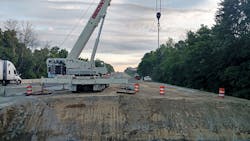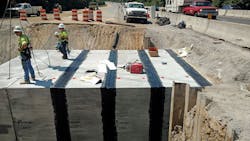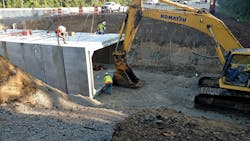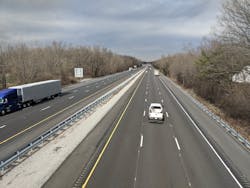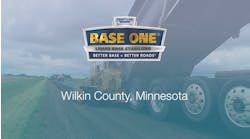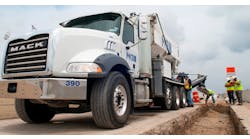By: Brian W. Budzynski
More often than not on a paving job, it’s not the paving itself that proves to be the most challenging aspect—it’s handling the traffic.
Live traffic in close proximity to an active work zone presents numerous challenges and dangers, not least of which is worker safety. But the placement of a well thought-out and consistent traffic management plan can significantly reduce, if not eliminate, much concern. And when safety is assured, the focus on getting the paving done the right way becomes that much easier.
Such was the case on the full-depth reconstruction of an 8-mile stretch of I-65 in Clark County, Ind., which received a 2018 National Asphalt Pavement Association award for Quality in Asphalt Paving.
“Traffic is typically our biggest foe,” Neil Stroud, project manager for prime contractor E&B Paving, told Roads & Bridges. “Especially jumping in and out of interstate traffic that may or may not be abiding by the speed limit. We had a few incidents take place, fender benders and the like, but worker safety was priority No. 1.”
On the range
This project bore a native geographic advantage from the get-go; the area, being in the southern portion of Indiana, just north of the Louisville, Ky., metropolitan area, is pretty flat. There’s some shale in certain areas, but this is farm country. Soybeans and corn range in seemingly endless order to the horizon line in either direction. I-65 is the main connector between Louisville and Indianapolis—between Nashville and Chicago when you come right down to it from a freight perspective. Consequently, the average daily traffic is about 50,000 vehicles, a 30% of which is heavy truck traffic. The pavement on this piece of the interstate—the project limits were defined as mile post 8 to mile post 16—had been in place since the 1950s, when the interstate system was originally built, and thus had more than exceeded its service life.
While the mix design that E&B would eventually employ was specified by INDOT, due to the design-build delivery method for this project E&B teamed up with design firm American Structurepoint and its sub-consultants to bid on the project.
“The project was split into two main segments, north and south, and we managed the overall project, in partnership with E&B on the paving, as well as drainage, lighting and so forth,” Wing Lau, project development director for American Structurepoint, told Roads & Bridges. “Due to the design-build nature of this project, INDOT had a specific scope for the project. What we did was try to come up with innovative means of cost savings measures to help E&B come up with a competitive bid on this project.”
Todd Stout, American Structurepoint’s project manager, went on to highlight the project’s management of traffic (MOT) plan as one of the main avenues of overall cost savings and safety focus: “One of the things we did during the MOT phase was to evaluate different pavement sections for the shoulders in order to determine if and how we could run the traffic on the shoulders by shifting it around as construction proceeded. We went through a pavement thickness evaluation, and as a result of that it was determined that the most cost-effective solution would be to do a mill-and-fill on the shoulders to make them useable as driving lanes during MOT in construction, and to move semis to the inside lanes to keep them off the shoulders.”
Securing the traffic management pattern would eventually allow E&B a good amount of latitude to complete the project in organized quadrants, which aided their ability to stay on schedule. “The lanes were 12 ft with 10 ft inside and outside shoulders. Phase 1 was the widening of the inside lane of the northbound side for the length of the job,” Stroud said. “Then we built crossovers to bring southbound traffic over to the northbound side. We had the NB and SB traffic divided by a barrier wall. We did this in quadrants, in four sections. So in the middle of the overall jobsite, the guys would move over to the other side. So each section was 4 miles long, on either side.” This approach would be of significant benefit, notably for the extensive drainage work that would be required.
Crews had a unique challenge when installing a new box culvert in that the old structure had become an ad-hoc sanctuary for bats. Workers applied a shotcrete to the upper inner wall of the culvert after installation was complete, in order to create a habitat the species could return to when the work was done.
Going batty
Considering the rural environment, ecological challenges were anticipated, though very little in that regard actually occurred. However, there was one interesting caveat that did.
In one section of the project a box culvert was in need for replacement, and prior to its removal project planners identified a curious, if ultimately sensible habitat in need of retention.
“There was corrugated rusted piping in one of the culverts in which bats were roosting,” Lau said. “So we had to monitor that before we could take out and replace that culvert. But luckily there was a point in the summer, about a two-week window, when the bats weren’t there, and that’s when we were able to go in and remove the culvert. We had to provide a comparable habit in the new culvert as a mitigation measure, by which the box culvert that was afterward installed was given a spray-on shotcrete to the underside of the top of the box, which provided a surface equivalent to what had been in the old culvert. So the bats could come back and re-habitate the next season.”
E&B Paving and American Structurepoint Inc. devised a paving schedule and traffic management plan that divided the project into quadrants, which improved both safety and overall productivity on the I-65 project.
Getting down to it
“We removed by milling the original PCCP, which dated back to the 50s,” Stroud said, “then we rubblized and removed the underlying concrete pavement to a depth of 16 in., which varied slightly area to area. In areas where we removed the old pavement, we also removed and relaid new drainage in the existing pipe bed. Other places we laid new draining and “safeloaded” [a process in which you fill the abandoned draining with grout] existing drainage where it was too deep to remove. We had to because by increasing the surface of the road, adding those extra lanes, also increased the surface runoff. So we had to both increase the size of the existing structures and add some more. All in all, we’re looking at approximately 9,200 linear ft of drainage and 88 new inlets.”
Once the drainage was installed, the “lifting” could begin. With a depth of 16 in. to contend with, E&B fleshed out its reconstruction in five lifts, in addition to soil stabilization. “Once we got on-grade with the subgrade,” Stroud said, “the cement guys came in with a big tiller, and they spread the cement on and then blended the soil and cement together, and laid it back down to approximate grade. Then we went back in and trimmed it to precise grade before moving forward.”
Working off a paving train that featured a Roadtec SB 2500 Shuttle Buggy feeding a Cat AP 1000 paver with a Topcon 5, P32 and dual SAS skis, crews put down the following sequence:
- 4 in. of QC/QA PG 76-22, 25-mm base;
- 2.5 in. of QC/QA PG 76-22, 19-mm OG;
- 5 in. of QC/QA PG 76-22, 25-mm base;
- 3 in. of QC/QA PG 76-22, 19-mm intermediate; and finally
- 1.5 in. of QC/QA PG 76-22, 9.5-mm SMA for the wearing course.
“We also earned a bonus for smoothness,” Stroud said. The target compaction was 92-93% for a full 100% payout. Using a troika of Cat 634 rollers and one Cat 534 roller, E&B was able to get 93.5% on all mixes with 6-8 passes in all areas.
“This project was meant to be completed in October 2017,” Stroud added, “but there were some permitting issues for INDOT that delayed our completion by a year. So that SMA course we did in 2018. Basically what we had to do last year was come in and remove an inch of temporary pavement we left in 2017, and then put down that 1.5 in. of SMA.”
About The Author: Budzynski is managing editor of Roads & Bridges.
